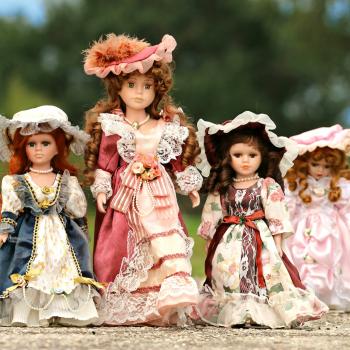I spent an hour this evening at the park with Sally and Bobby. I put Bobby in a swing, and gave him a good push, and you should have seen his face—it was like he’d just realized he had wings! After he’d been in the swing for about fifteen minutes, I took Bobby out to take him to play with something else. He immediately stiffened and started screaming, bucking and thrashing until it was all I could do to hold onto him (he’s getting big!). So I put him down and watched him crumple, collapsing on his side and wailing like the world had just ended.
I knew what he wanted—it was clear. Bobby was upset that I had taken him out of the swing and was making that known. Nevertheless, the voices in my head inevitably show up at moments like these, the voices of my parents, channeling the Pearls.
He’s trying to manipulate you.
You can’t let him win.
You mustn’t let him get his way.
You need to nip his rebellion in the bud.
Fortunately, it’s been long enough that these voices are no more than a contrast against which I live my life. And so, without skipping a beat, I put Bobby back in the swing. He immediately quieted and gave me the biggest smile. I gave his swing a push and he broke into spontaneous laughter.
See, being a baby, Bobby doesn’t know any words yet. This means that the only way he can communicate what he wants or needs is through fussing and crying. What he did this evening was not rebellion, it was communication. And he communicated really well, too! I knew exactly what he wanted, and since I love him and care about what he wants and since it wasn’t any trouble anyway, I gave him what he wanted. I hadn’t taken him out of the swing because we had to leave, I had taken him out because I thought he had probably had enough—and he responded by letting me know otherwise. By communicating. You know, the only way babies have to communicate.
But here is what Michael and Debi Pearl have to say about that in their child training manual, which my parents followed religiously:
THROWING A FIT—TEMPER TANTRUMS
My nine- and eleven-year-old daughters came in from a neighbor’s house complaining of a young mother’s failure to train her child. A seven-month-old boy had, upon failing to get his way, stiffened, clenched his fists, bared his toothless gums and called down damnation on the whole place. At a time like that, the angry expression on a baby’s face can resemble that of one instigating a riot. The young mother, wanting to do the right thing, stood there in helpless consternation, apologetically shrugged her shoulders and said, “What can I do?” My incredulous nine-year-old whipped back, “Switch him.” The mother responded, “I can’t, he’s too little.” With the wisdom of a veteran who had been on the little end of the switch, my daughter answered, “If he is old enough to pitch a fit, he is old enough to be spanked.”
The Pearls would say that Bobby was throwing a temper tantrum—wailing to get his way—and that I should refuse to “give in” to his attempt to control me. Indeed, my mother used to “train babies out of crying” by refusing to get them out of their cribs when they were crying, instead waiting for them to be quiet and then “rewarding” them for being cheerful by getting them up. Unless a baby was hungry, had a dirty diaper, or was in pain, its cries were assumed to to be rebellion—and rebellion must not be rewarded.
I have to say, parenting is so much more pleasant when you stop viewing your cihldren’s every action through an adversarial lens—when you stop seeing them as little hellions trying to “control” or “manipulate” you. It’s also a lot more pleasant when you actually know something about child development, come to think of it—and when you’re willing to actually listen to your child instead of imputing a whole book full of terrible ideas onto them.
And honestly? I’m pleased to know that Bobby is old enough to know when he wants something and to communicate that to me. That should be seen as a good thing—he’s starting to develop his own personality and knowledge of himself as separate from those around him, the first step on the long process of growing up. 🙂














